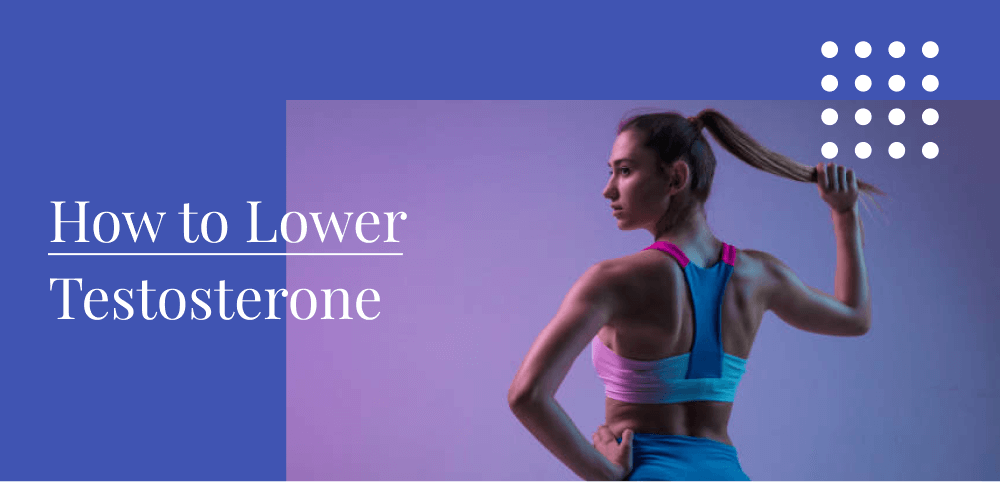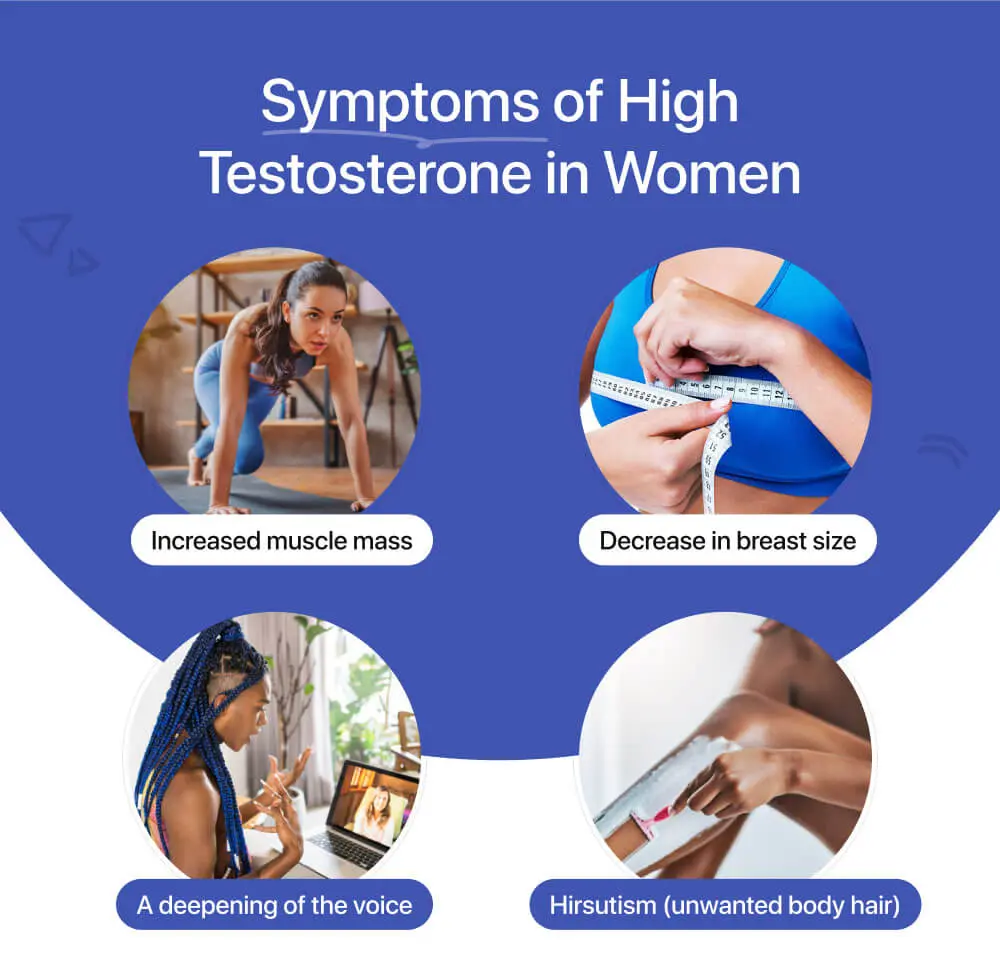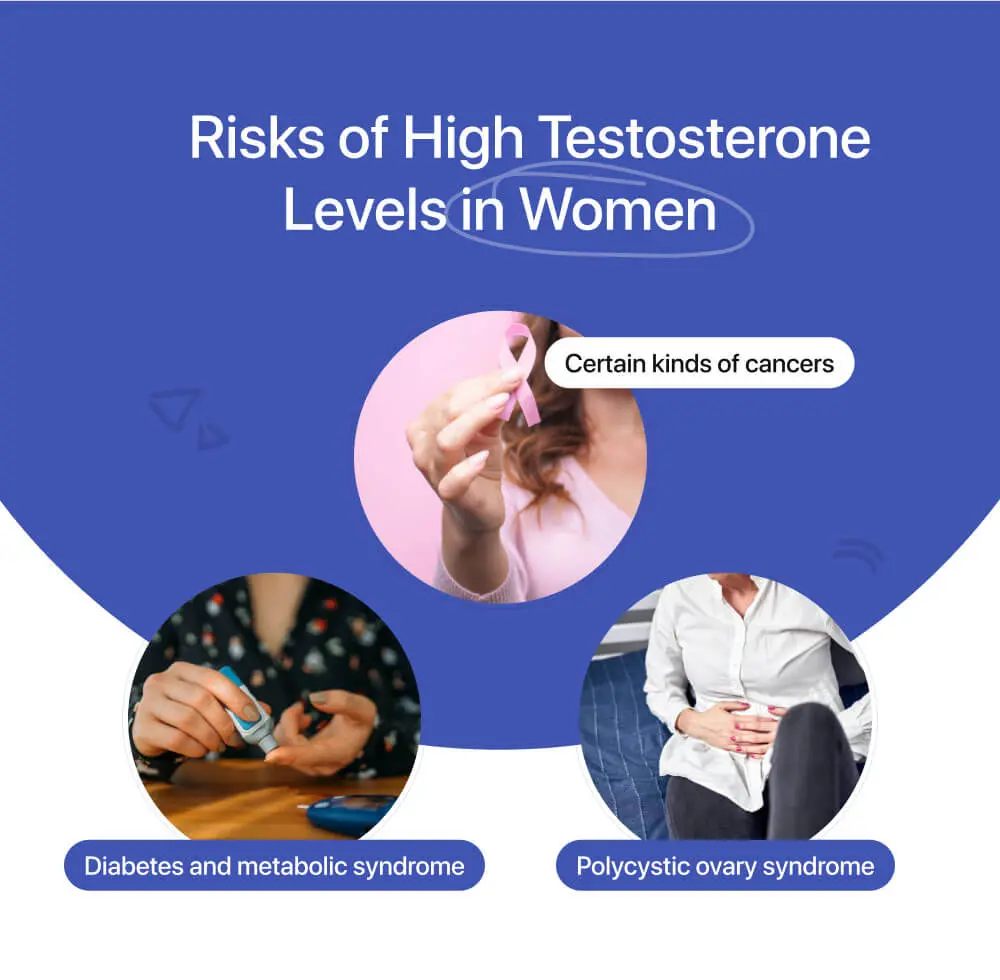While testosterone is an important hormone in men and women, high levels can cause several distressing symptoms and possibly even raise your risk for some diseases. For women in particular these can be more noticeable and include excessive hair, decreased breast size, and a deeper voice.
Although it can cause numerous symptoms itself, higher testosterone levels can also be a sign of something bigger going on in your body. We’ll look at exactly what testosterone is, its main function, what can cause levels to be elevated and natural ways you can bring it down.
Key Takeaways
- Testosterone is a key hormone with several functions in the body.
- Normal testosterone levels differ between males and females.
- High levels can have several different causes.
- PCOS can be a common cause of altered hormonal levels in women.
- It’s possible to lower testosterone by consuming certain herbs and foods, engaging in chronic endurance exercise, and using medications.
What Is Testosterone?
Testosterone is the main anabolic steroid hormone in the body. Testosterone is produced by males in their testicles, and women also make it in much smaller amounts in the adrenal glands and ovaries. The pituitary gland plays a large role in how much is made. Some of testosterone’s main functions include:
- Causing the voice to deepen during puberty in males
- Muscle growth and maintaining muscle mass
- Growth of facial and body hair during puberty
- Bone density and growth
- Production of red blood cells
- Sex drive (libido) in both sexes
- Sexual function
- Production of sperm
- Distribution of body fat
- Having more energy
- Sleep quality
- Mental health
How Does Testosterone Work?
Primarily, testosterone works by activating specific genes to express or present certain characteristics. As it circulates in the blood, it binds to the androgen receptors found on a cell’s surface.
This helps these cells to express, or activate the genes responsible for primary and secondary sexual characteristics and other physical attributes. For example, testosterone can encourage muscle and hair growth or regulate distribution of body fat in both sexes.
Summary
Testosterone is a key anabolic hormone that activates genes to express a variety of characteristics in cells and body systems.
Normal Testosterone Ranges
Testosterone levels vary greatly in men and women. The healthy range for men will be much higher, while for women, it’s lower.
In men, the normal range is typically 280 to 1,100 ng/dL. For women, normal levels of testosterone are between 15 to 70 ng/dL.
Summary
Testosterone levels are quite different between the two genders, with women having much lower amounts.
What Are the Symptoms of High Testosterone in Men?
Several symptoms of high testosterone can overlap in men and women. Some of the main signs in males include
- Oily skin and acne
- Hair loss on your head
- Lower sperm quality and count
- Enlarged prostate
- Weight gain
- Mood swings
- Irritability
- Fluid retention and swelling in the extremities
- Liver disease
Summary
While testosterone is an important hormone, excess amounts can cause numerous symptoms.
What Are the Symptoms of High Testosterone in Women?
Signs of high testosterone levels can be more noticeable in women. The main effects of low testosterone in women include:
- Hirsutism (unwanted body hair)
- A deepening of the voice
- Increased muscle mass
- Decrease in breast size
Summary
Women can have many of the same symptoms of high testosterone as men, but there are certain symptoms that can be more noticeable in women.
What Causes High Testosterone in Women?
Several diseases can cause testosterone to be elevated. While higher testosterone levels in women can be an isolated problem related to diet or lifestyle, it can also indicate something more.
Polycystic Ovarian Syndrome (PCOS)
One of the most common causes of high testosterone in females is Polycystic Ovary Syndrome. It’s thought to affect up to 10% of women. Women with PCOS produce higher levels of several hormones, including testosterone, and often experience irregular periods.
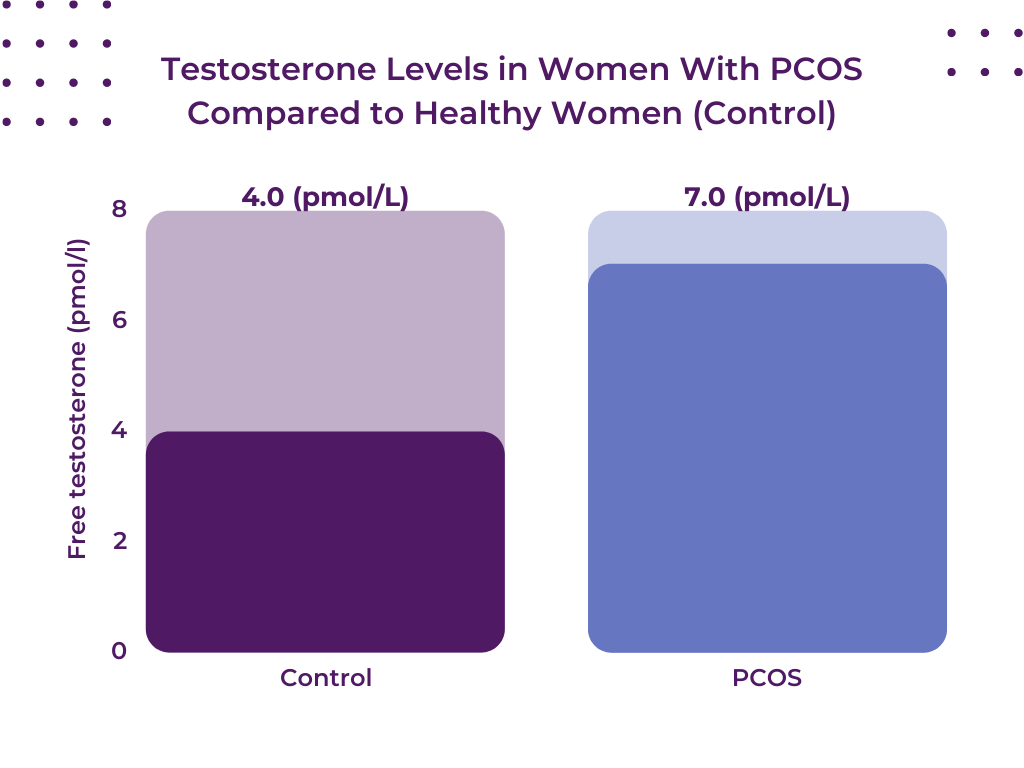
Source: https://www.ncbi.nlm.nih.gov/pmc/articles/PMC4195601/
A woman with any of the symptoms we discussed earlier should see a doctor for proper diagnosis as Polycystic Ovary Syndrome can have several complications such as infertility. A healthy diet and some medications are usually the primary treatment.
Congenital Adrenal Hyperplasia (CAH)
Congenital Adrenal Hyperplasia is a condition affecting the adrenal glands, and it’s present when the baby is born. Since these glands produce several vital hormones, including cortisol and aldosterone, the condition can affect several areas. Early diagnosis and treatment will be important to proper management.
Connection to Blood Sugar
Blood sugar and insulin can also affect testosterone levels in a woman. High blood sugar, possibly caused by decreased insulin sensitivity or insulin resistance, can cause testosterone levels to rise. When your insulin is elevated, it can serve as a signal for your body to produce more testosterone.
It’s recommended to see your doctor to prevent complications associated with diabetes. Having PCOS can also increase your chance of metabolic syndrome, resulting in higher sugar levels. It’s important to balance blood sugar and improve insulin sensitivity for your overall health.
Hormone Replacement Therapy
Hormone replacement therapy is one more potential cause of elevated testosterone levels. If you suspect this is the case for you, you should speak with your doctor to see if adjusting your dose is appropriate.
Summary
Several conditions can cause higher levels of testosterone in women. Since some of them can have serious complications, early detection and treatment are important.
How Is High Testosterone Diagnosed?
If your doctor suspects you have elevated testosterone they’ll order a blood test to confirm. Tests can measure free testosterone or total testosterone levels. Free testosterone refers to levels of the hormone where it’s not bound to any other proteins.
Total testosterone levels refer to all of the testosterone in your blood. About 98% of testosterone is bound to sex hormone binding globulin, which means roughly 2% is free.
Summary
High testosterone is diagnosed by measuring levels in your blood. There are two main tests doctors can use.
Risks of High Testosterone Levels
Elevated testosterone can do more than produce unwanted symptoms. It can also increase your risk of certain diseases and complications. These can differ between the two genders.
In Men
There’s been speculation that the higher testosterone levels in men may be a factor why males have a lower life expectancy than females. The reality is your chance of developing several diseases is higher. These include
- Heart disease and heart attacks
- Liver disease
- Blood clots
- Prostate problems
In Women
Women can have several of the same risks as men, but there are a few things more unique to women. Risks of all of the following are higher.
- Diabetes and metabolic syndrome
- Polycystic ovary syndrome
- Certain kinds of cancers
Summary
Higher levels of testosterone can put men and women at increased risk of several diseases.
How to Reduce Testosterone Levels
There are numerous ways to reduce testosterone, including medication, certain foods, herbs, and even specific kinds of exercise. We’ll explain each of these in detail.
Natural Ways to Reduce Testosterone
Let’s look at some ways of how to lower testosterone naturally. This essentially falls into two categories, diet, and exercise. Let’s start with diet first.
Dietary Changes
There’s evidence from different studies to suggest that a variety of foods can help bring testosterone levels down. Here are some of the main ones to consider.
Soy
Products derived from soybeans include items like soy milk, tofu, and soy protein isolate. Soy is noted for its high content of phytoestrogen isoflavones which can interfere with the function of androgen receptors and therefore reduce the effects of testosterone.
Phytoestrogen isoflavones are plant based substances that mimic human estrogen. Soy protein can also be an alternative to whey protein supplementation if you want to achieve low t. More research is still needed on phytoestrogens and the effects of soy foods on the human body and hormones.
Mint Family
Spearmint tea has some evidence behind it that it can affect testosterone levels. Spearmint tea has anti-androgenic effects and can be helpful for lowering t levels in women. One study found women in the spearmint tea group who drank a cup of tea daily had a significant reduction of testosterone levels compared to a placebo tea [1].
Green Tea
Green tea is known for being a rich source of antioxidants and other health benefits. However, it can also have direct testosterone lowering effects. In some cases, this could be considered an unwanted side effect, but in this case, it’s exactly what we’re looking for.
Green tea can increase your levels of sex hormone binding globulin (SHBH) which reduces free serum testosterone levels. Free testosterone levels are usually more important than total testosterone.
Licorice Root
Licorice root is different from the licorice candy people like to eat. Recent studies have uncovered that licorice root can affect hormone levels. A small study with women showed 3.5 grams of licorice root daily lowered testosterone levels by 32% with one menstrual cycle [2]. However, one note of caution, licorice consumption can raise blood pressure.
Trans Fats
Trans fats probably aren’t something you would think of, but interestingly, research has shown they can reduce testosterone levels. One study showed adult men with a higher intake of trans fats had 15% lower t levels compared to those with the lowest intake [3].
Additionally, their testicular volume and testicular function were also impaired. Needless to say, trans fats carry many health risks and shouldn’t be relied on for reducing t levels.
Vegetable Oil
Vegetable oil is commonly used in preparing fried foods and in salad dressing. Vegetable oils are a source of polyunsaturated fatty acids. A study with 69 men demonstrated regular consumption of polyunsaturated fatty acids was linked to lower testosterone levels [4]. Polyunsaturated fats also have many links to heart health.
Flaxseed
Flaxseed and testosterone also have a relationship with each other. Flaxseed can lower testosterone due to the presence of lignans. These compounds bind to testosterone and can help remove it from your body.
Flaxseed supplementation can be a rich source of omega 3 fatty acids which have also been shown to reduce testosterone and are great for your health.
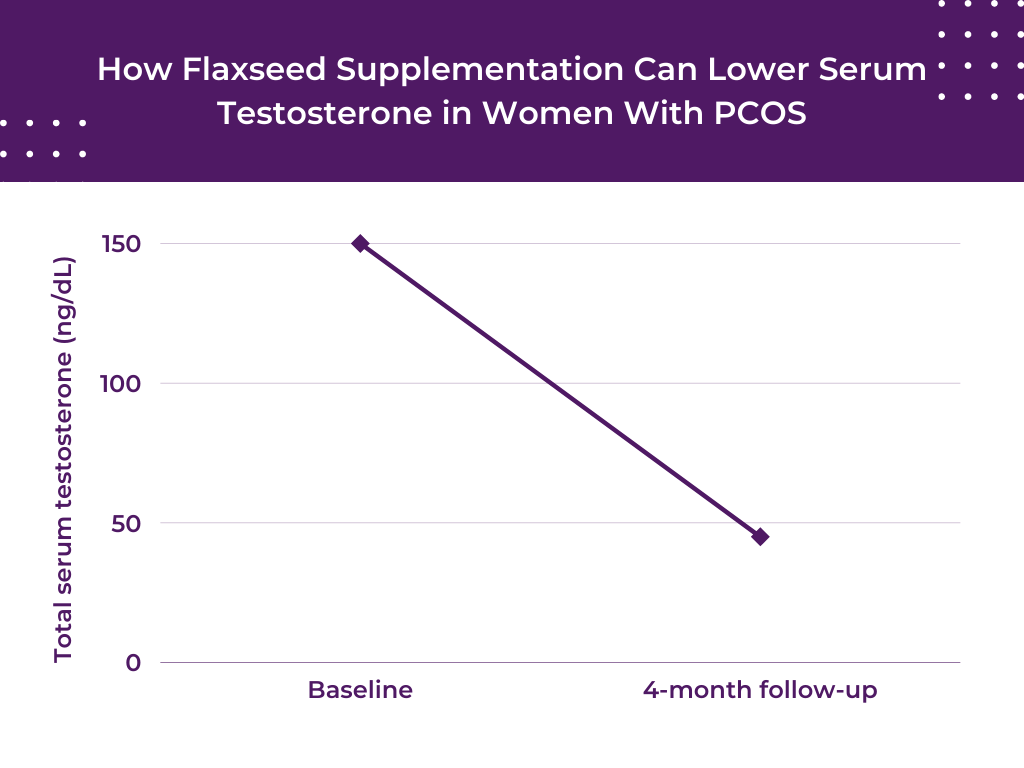
Source: https://www.ncbi.nlm.nih.gov/pmc/articles/PMC2752973/
Vitamin D
Vitamin D is an essential fat soluble vitamin important for bone health. Research has shown it can lower your t level naturally. Supplementation can be especially helpful in the winter months if you live in northern regions.
Alcohol
Studies have shown that higher consumption of alcoholic beverages, especially in men can cause testosterone levels to drop. Women looking to lower testosterone should be cautious with alcohol though, it may have the opposite effect [5]. Heavy drinking as medication is probably not the best route to take as there are far healthier options.
Processed Foods & Sugar
Since processed foods tend to be high in sugar and trans fat, and knowing the effects discussed above, we can see how these can lower testosterone. However, processed foods and trans fat are linked to numerous health problems.
Sugar sweetened beverage intake and other sources of sugar (like baked goods) can also result in significantly lower t levels in men. However, more research needs to be done on women. Like trans fats, you want to be cautious with how much sugar you consume.
Nuts
Nuts are a healthy food high in fiber, healthy fats, minerals, and vitamins. Certain nuts can also help decrease testosterone levels. In women with PCOS, both walnuts and almonds were shown to increase sex hormone binding globulins and improving metabolic parameters in PCOS [6].
Foods That Don’t Actually Kill Testosterone
Be aware some foods can increase your testosterone levels instead. However, if you’re looking at how to boost testosterone levels, the following foods are perfect.
- Salmon (and other fatty fish)
- Dark Greens
- Cocoa products
- Avocados
- Eggs
- Shellfish
Lifestyle Changes
Working out is one lifestyle change you can introduce to decrease testosterone levels. Exercise and testosterone levels are linked but it’s important you do specific exercises. For example, resistance exercise has been shown to boost testosterone. Instead, endurance activities like long distance running can help bring testosterone down.
How to Lower Testosterone Levels With Medication
Prescription medications are still one of the most powerful ways to lower testosterone. These would typically be prescribed to treat certain conditions, where it’s been shown to be the cause of your elevated testosterone. Prednisone, a powerful steroid medication used to treat inflammation, can significantly lower testosterone.
Summary
If high t levels are a problem for you, there are several ways you can reduce it through supplementation, nutrition, endurance exercises, and medications. A lot of the research is still based on animal studies, with more research needed on humans.
How to Lower Testosterone in Women
There are certain supplements that raise t levels in males that can have the opposite effect when taken by women. One thing you can consider taking is zinc. Zinc has been shown to help balance hormone levels in women with PCOS, help with hormone imbalances and suppress androgens.
Several other supplements can be especially helpful in women with PCOS. These include white peony, reishi mushrooms, licorice, spearmint tea, and nettle.
Summary
There are a few products like zinc that work better in women to regulate reproductive hormones and can help fix a hormone imbalance. Other herbs can also be beneficial for women with polycystic ovary syndrome.
FAQ
Check out some of the most common questions below.
Can Testosterone Levels Be Reduced?
Testosterone levels can definitely be reduced. Herbs, consuming certain foods, and endurance activities can all influence testosterone levels.
How Do You Treat High Testosterone Levels?
If you suspect you have a medical condition causing your hormone imbalance, it’s best to seek professional medical advice. A doctor can order the appropriate tests to find the cause and devise a treatment plan.
What Does High Testosterone Do to a Woman?
You may notice several adverse effects such as hirsutism, irregular ovulation, a deeper voice, and increased muscle.
What Kills Testosterone the Most?
Medications will most likely have the greatest effect, but these would be prescribed only in specific cases. Instead, you can supplement with any of the foods we discussed earlier.
Does Masturbation Decrease Testosterone?
Several studies have shown that masturbation doesn’t have any long-term influence on testosterone.
Which Exercises Reduces Testosterone in Women?
Exercising regularly is important to a sense of well-being and overall health. Running and other endurance exercises can be helpful. Be careful to avoid too much weight lifting as this is one of the ways as to how to increase testosterone.
Conclusion
Testosterone is one of the important male hormones, which is also found in women to a lesser extent. Many factors can affect your hormone levels, including age, gender, dietary patterns, and some medical conditions.
If you’re experiencing symptoms of elevated testosterone, it’s important to see a doctor and get things checked out. They can order tests to check levels in your bloodstream and identify any medical causes.
References
- P;, Grant. “Spearmint Herbal Tea Has Significant Anti-Androgen Effects in Polycystic Ovarian Syndrome. A Randomized Controlled Trial.” Phytotherapy Research : PTR, U.S. National Library of Medicine, https://pubmed.ncbi.nlm.nih.gov/19585478/.
- Armanini D;Mattarello MJ;Fiore C;Bonanni G;Scaroni C;Sartorato P;Palermo M; “Licorice Reduces Serum Testosterone in Healthy Women.” Steroids, U.S. National Library of Medicine, https://pubmed.ncbi.nlm.nih.gov/15579328/.
- Chavarro, Jorge E, et al. “Trans Fatty Acid Intake Is Inversely Related to Total Sperm Count in Young Healthy Men.” Human Reproduction (Oxford, England), Oxford University Press, Mar. 2014, https://www.ncbi.nlm.nih.gov/pmc/articles/PMC3923511/.
- H;, Nagata C;Takatsuka N;Kawakami N;Shimizu. “Relationships between Types of Fat Consumed and Serum Estrogen and Androgen Concentrations in Japanese Men.” Nutrition and Cancer, U.S. National Library of Medicine, https://pubmed.ncbi.nlm.nih.gov/11525593/.
- CJ;, Apter SJ;Eriksson. “The Effect of Alcohol on Testosterone Concentrations in Alcohol-Preferring and Non-Preferring Rat Lines.” Alcoholism, Clinical and Experimental Research, U.S. National Library of Medicine, https://pubmed.ncbi.nlm.nih.gov/12878927/.
- Kalgaonkar S;Almario RU;Gurusinghe D;Garamendi EM;Buchan W;Kim K;Karakas SE; “Differential Effects of Walnuts vs Almonds on Improving Metabolic and Endocrine Parameters in PCOS.” European Journal of Clinical Nutrition, U.S. National Library of Medicine, https://pubmed.ncbi.nlm.nih.gov/21157477/.
